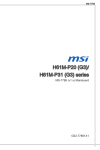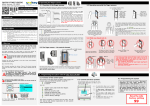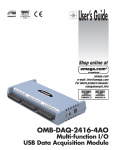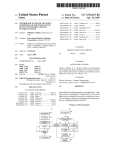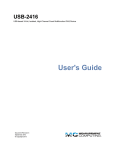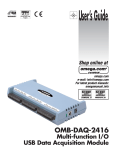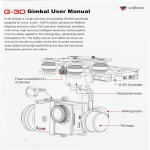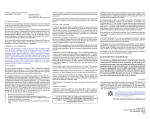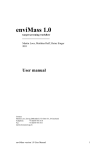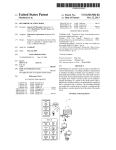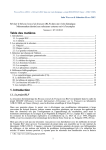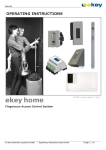Download Tuner selection in digital broadcasting receiver having multiple tuners
Transcript
US008228442B2 (12) United States Patent (10) Patent No.: Yi (54) US 8,228,442 B2 (45) Date of Patent: TUNER SELECTION IN DIGITAL 7,929,062 B2* Jul. 24, 2012 4/2011 Oh .............................. .. 348/732 BROADCASTING RECEIVER HAVING 2006/0035610 A1* 2/2006 Potrebic ................... .. 455/178.1 MULTIPLE TUNERS 2006/0150219 A1 7/2006 Lee et al. FOREIGN PATENT DOCUMENTS (75) Inventor: Ho Yi, Seongnam-si (KR) EP 0 669 725 6/1994 (73) Assignee: HUMAX Co., Ltd., Gyeonggi-Do (KR) EP 0 967 746 12/1999 EP 0 967 749 12/1999 (*) EP JP 1 355 496 2004064478 10/2003 2/2004 Notice: Subject to any disclaimer, the term of this patent is extended or adjusted under 35 U.S.C. 154(b) by 1317 days. (21) Appl' NO‘: 11/872’282 (22) Filed European Search Report dated Dec. 19, 2008. a European Search Report dated Oct. 21, 2011. * Cited by examiner Foreign Application Priority Data N 16 2006 0V‘ (58) I Prior Publication Data US 2008/0117335 A1 May 22, 2008 (30) (51) European Search Report dated Feb. 9, 2009. Oct 15 2007 i (65) OTHER PUBLICATIONS ’ KR ( Int. Cl. H04N 5/50 H04N 7/20 P1’imary Examiner * Kristine Kincaid 10 2006 0113200 ) """"""""""" " ' ' (74) Attorney, Agent, or Firm 4 KED & Associates, LLP (2006.01) (2006.01) (57) G06F 3/00 (2006 ' 01) CI. ...... Fleld of Classl?catlon Search """" " 348/731’732; 1_ _ ?l f 1 hh_ 725/38’ 63 See app lcanon e or Comp ete searc lstory' . References Cited (56) Assistant Examiner * Gigi L Dubasky ABSTRACT A d-g- g rece1ver hav1n - g mu 1 t1-p1 e tuners and a 1 1ta 1b roa d cast1n method Of Selecting a tuner in the broadcasting receiver. An embodiment of the present invention attempts to tune each tuner With transponder data of a satellite being connected to a digital broadcasting receiver having multiple tuners an d se ects one tuner to searc 1 _ c anne s accor in h 1 d‘ g to the result of tuning. The transponder input procedure and the Us PATENT DOCUMENTS following tuner selection procedure can be omitted such that t e tuner se ect1on 5,757,441 A 5/1998 Lee et a1. 6,133,910 A 6,519,011 B1 10/2000 Stinebruner 2/2003 Shendar h 6,980,529 B1 * 12/2005 Arsenault ................... .. 370/316 1 i SELECTING A TUNER CGPLEI'IOII FIATE END can 1 e . b e s1m ' Pl'? ‘1 11 Claims, 10 Drawing Sheets HAVING HIKHEST TUNING SELECTING A TLIIER HAVING HIGHER PRIl?ITV P roce dure DISPLAYING Ul SIHBEN FIR SELEGTING TUNER US. Patent Jul. 24, 2012 Sheet 1 0f 10 US 8,228,442 B2 FIG. 1 PRIOR ART Y SET ANTENNA CONNECTION STATE m T10 SET ANTENNA w 120 SELECT TUNER I» T30 i SEARCH CHANNEL w 140 US. Patent Jul. 24, 2012 Sheet 2 0f 10 F I G. 2 SATE_L I TE 1 (H 11 C"! 12 CH 1L US 8,228,442 B2 US. Patent Jul. 24, 2012 Sheet 3 or 10 FIG. 3 SATELL l TE 1 TPT TF2 TPM US 8,228,442 B2 US. Patent Jul. 24, 2012 Sheet 4 0f 10 FIG. 4 SATELLITE ' TP 1 (SI-111 CI- 112 (II-113 CH 11L US 8,228,442 B2 US. Patent Jul. 24, 2012 Sheet 5 or 10 FIG. 5 F l RST TUNER SECOND TUNER S GNAL L N E S l NGLE TUNER TYPE US 8,228,442 B2 US. Patent Jul. 24, 2012 Sheet 6 or 10 FIG. 6 FIRST TUNER SECOND TUNER SIGNAL LINE LOOP THROUGH TYPE US 8,228,442 B2 US. Patent Jul. 24, 2012 Sheet 7 or 10 US 8,228,442 B2 FIG. 7 F l RST TUNER ,2 SECOND TUNER 44444 _ _E In W SIGNAL LINE1 SEPARATE TYPE US. Patent Jul. 24, 2012 US 8,228,442 B2 Sheet 9 0f 10 FIG. 9 I START I II AUTO CHANNEL SETUP IDDE w 210 TUNING EACH TUNER WITH TRANSPONDER DATA DF SATELLITE TO BE SEARCHED ~220 CI'ECKING TUNING CINPLEI'IGII RATES AT EACH TUNER TUNING CDLPLETI 0N RATES AT EACH TUNER ARE D I FFHIENT'? 240 ND YES ( SELECTI NG A TUNER HAVING HIGHEST TUNING CINPLEI'ION RATE SAME SIGNALS? YES ( SELECTING A TUNER ~270 HAVING HIGHER PRIIBITY NO 1 ,1 280 DISPLAYING UI SCREEN FIB SELECTING TUNER 290 SELECTING TUNER J END US. Patent Jul. 24, 2012 US 8,228,442 B2 Sheet 10 0f 10 FIG. I O START ~ 310 MANUAL CHANNEL MODE I SINLLTANEIXISLY TUNING EACH TUNER WITH TRANSPDNDER DATA 0F SATELLITE TO BE SEARCHED 330 S IMULTAI‘EOUS TUNING C(HPLEI'E? YES N0 w 35° SME 5mm? YES SELECTING A TUNER HAVING HlG-ER PRIORITY SELECTING A TUNER COMPLETING TUNING N0 ( q 360 ,1 370 ,_/ DISPLAYING u| SCREEN FOR SELEGTI NG TUNER SELECT I NG TUNER I (END) 340 US 8,228,442 B2 1 2 An aspect of the present invention features a method of TUNER SELECTION IN DIGITAL BROADCASTING RECEIVER HAVING MULTIPLE TUNERS selecting a tuner in a digital broadcasting receiver having multiple tuners. In the method, each tuner is tuned with at least one of transponder data corresponding to a satellite to be searched, tuning completion rates of each tuner are produced, CROSS-REFERENCE TO RELATED PATENT APPLICATIONS and a tuner to search channels of the satellite is selected to correspond to the tuning completion rates. This application claims the bene?t of Korean Patent Appli cation No. 10-2006-0113200, ?led on Nov. 16, 2006, in the Korean Intellectual Property Of?ce, the disclosure of which is Another aspect of the present invention features a method of selecting a tuner in a digital broadcasting receiver having multiple tuners. If only one tuner completes tuning as a result incorporated herein in its entirety by reference. of attempting to tune each tuner with at least one of transpon der data corresponding to a satellite to be searched, channels BACKGROUND OF THE INVENTION of the satellite are searched by the tuner. If two or more tuners complete tuning, one tuner is selected to search the channel 1. Field of the Invention The present invention relates to a digital broadcasting according to the identicalness of output signals from the tuners. receiver, particularly to a digital broadcasting receiver having Yet another aspect of the present invention features a digi tal broadcasting receiver, which includes: a plurality of tun multiple tuners and a method of selecting a tuner in the digital broadcasting receiver. 2. Description of the Related Technology Generally, a digital broadcasting receiver is equipped with a PVR (Personal Video Recorder) function for recording a digital broadcasting program on a recording medium such as an HDD (Hard Disc Drive), and canbe connected to a satellite broadcasting antenna and a television. This digital broadcast 20 plurality of tuners in accordance with a plurality of tuning completion rates being produced by tuning the plurality of 25 tuners with the transponder data. Still another aspect of the present invention features a 30 tuners; a controller, resulted from attempting to tune each tuner with transponder data corresponding to a satellite to be searched, selecting one tuner to search a channel if only one tuner completes tuning, or selecting one tuner from the plu ing receiver sometimes has multiple tuners so as to allow a user to watch one channel in a PIP (Picture in Picture) mode or record one channel while watching another channel. In addition, the digital broadcasting receiver has a channel search function, which should be performed before the ?rst use of the digital broadcasting receiver and is performed periodically to update channel data in use. FIG. 1 is a ?owchart showing how a digital broadcasting receiver having two tuners typically searches for channels. Referring to FIG. 1, in step 110, an antenna of a satellite digital broadcasting receiver, which includes: a plurality of rality of tuners according the identicalness of output signals of the tuners if two or more tuners complete tuning; and a user interface, displaying a UI (User Interface) screen to receive an input signal. 35 connected to the digital broadcasting receiver is physically con?gured to the digital broadcasting receiver, and this pro BRIEF DESCRIPTION OF THE DRAWINGS FIG. 1 is a ?owchart showing a typical channel search cess is called “antenna connection state setup.” procedure in a digital broadcasting receiver having multiple After setting the antenna connection state, in step 120, “antenna setting” is performed to con?gure satellite data, 40 LNB data, on/ off of 22 KHZ tone, and a value of Diseqc switch, which are antenna setting conditions. FIGS. 2 to 4 show a menu list in a satellite connected to a The Diseqc switch is a device for automatically selecting FIGS. 5 to 7 show the antenna connection state of a digital broadcasting receiver having two tuners; to four (4) antennas. After setting the antenna, in step 130, a tuner connected to the antenna is selected, and this is referred to as “tuner selec tion.” After the antenna setting and before the tuner selection, or 45 after the tuner selection, transponder data is inputted in step 50 present invention; FIG. 9 is a ?owchart of selecting a tuner in a digital broad casting receiver in accordance with an embodiment of the FIG. 10 is a ?owchart of selecting a tuner in a digital 55 60 DESCRIPTION OF CERTAIN INVENTIVE EMBODIMENTS As described above, the embodiment of present invention can search channels by automated input step of transponder data and selecting step of tuner thereof. Also, another embodiment of present invention can simplify the tuner selec tion procedure and save tuner selection time by allowing user’s manual tuner selection only when output signals of The present invention provides a digital broadcasting receiver and a method of selecting a tuner that make a tuning by use of transponder data in a transponder list corresponding thereby automating or simplifying the tuner selection. present invention; and broadcasting receiver in accordance with another embodi ment of the present invention. procedure had to be repeated every time a new channel is added. to a satellite connected to the digital broadcasting receiver and select a tuner in accordance with the tuning result, FIG. 8 is a block diagram of a digital broadcasting receiver having two tuners in accordance with an embodiment of the Not only is this costly and time-consuming, but also this SUMMARY OF CERTAIN INVENTIVE ASPECTS tuners; digital broadcasting receiver; an antenna when there are plural antennas, and can select up 140 for “channel search”. Conventionally, the user had to manually select the tuner. However, since it is not easy for ordinary users to understand the input condition for tuner selection, most users had to rely on the technician to setup the digital broadcasting receiver. ers; a transponder data storage, storing at least one of tran sponder data of a satellite to be searched; and a controller, selecting one tuner to search a channel of the satellite from the each tuner are different. 65 Since there can be a variety of permutations and embodi ments of the present invention, certain embodiments will be illustrated and described with reference to the accompanying US 8,228,442 B2 3 4 drawings. This, however, is by no means to restrict the present FIG. 2, or transponders (TP 1-TP M) included in satellite 1, as invention to certain embodiments, and shall be construed as shown in FIG. 3. Also, a sub menu of TP 1 consists of chan nels (CH111-CH11L) included in TP 1, as shown in FIG. 4. including all permutations, equivalents and substitutes cov ered by the spirit and scope of the present invention. FIG. 5 to FIG. 7 show the antenna connection state of the Terms such as “?rst” and “second” can be used in describ digital broadcasting receiver having two tuners. ing various elements, but the above elements shall not be Referring to FIG. 5 to FIG. 7, the antenna connection state can be one of a single tuner type, loop-through type, and separate type. The single tuner type connects the antenna to one tuner, and if the digital broadcasting receiver has two restricted to the above terms. The above terms are used only to distinguish one element from the other. For instance, the ?rst element can be named the second element, and vice versa, without departing the scope of claims of the present inven tuners, the antenna is connected to one of the ?rst tuner or the tion. The term “and/or” shall include the combination of a plurality of listed items or any of the plurality of listed items. When one element is described as being “connected” or “accessed” to another element, it shall be construed as being connected or accessed to the other element directly but also as 5 second tuner (FIG. 5). In the loop-through type, two tuners share an LNB signal inputted via one signal line (FIG. 6), and in the separate type, the LNB signals coming from two signal lines are tuned by two tuners independently (FIG. 7). possibly having another element in between. On the other Hereinafter, some embodiments will be described in detail hand, if one element is described as being “directly con nected” or “directly accessed” to another element, it shall be construed that there is no other element in between. The terms used in the description are intended to describe certain embodiments only, and shall by no means restrict the with reference to the accompanying drawings. In describing the present invention, identical or corresponding elements will be given the same reference numerals, regardless of the 20 FIG. 8 is a block diagram of a digital broadcasting receiver having two tuners according to an embodiment of the present invention. present invention. Unless clearly used otherwise, expressions in the singular number include a plural meaning. In the present description, an expression such as “comprising” or “consisting of’ is intended to designate a characteristic, a ?gure number. As shown in FIG. 8, the digital broadcasting receiver 25 according to this embodiment includes a ?rst tuner 11, a number, a step, an operation, an element, a part or combina second tuner 13, a controller 20, a transponder data storage tions thereof, and shall not be construed to preclude any 30, a channel data storage 40, and a user interface 50. Each of the ?rst tuner 11 and the second tuner 13 receives a converted signal from an LNB (Low Noise Block down presence or possibility of one or more other characteristics, numbers, steps, operations, elements, parts or combinations thereof. 30 Unless otherwise de?ned, all terms, including technical terms and scienti?c terms, used herein have the same meaning as how they are generally understood by those of ordinary skill in the art to which the invention pertains. Any term that is de?ned in a general dictionary shall be construed to have the same meaning in the context of the relevant art, and, unless otherwise de?ned explicitly, shall not be interpreted to have an idealistic or excessively formalistic meaning. Hereinafter, for the convenience of description, an example of having two tuners (a ?rst tuner and a second tuner) will be mainly described. It shall be apparent, however, that the converter), which converts high frequency signals inputted from the antenna, and extracts video signals and audio signals from the converted signals for transmission to a TV or another 35 40 device. The LNB converts a high frequency of 4~l2 GHZ trans mitted from a satellite into an intermediate frequency of l GHZ, and is located in the center of an antenna. The controller 20 operates on receiving a tuner selection request by the user or on a predetermined period to recogniZe the transponder list, i.e., the frequency list to be searched by present invention can be embodied in the same or similar a tuner in charge, obtains channel data by providing each transponder data in the recogniZed transponder list to the manner in a case of having three or more tuners. tuner in charge, and stores it on the channel data storage 30. In addition, before describing some embodiments of the present invention, a menu list in a satellite connected to a 45 digital broadcasting receiver and an antenna connection state will be described in detail. FIG. 2 to FIG. 4 show a menu list in a satellite connected to the digital broadcasting receiver. Referring to FIG. 2 to FIG. 4, each satellite has more than one transponder (TP) data. Several tens of transponders are 50 not each tuner completes tuning, and whether or not output signals from each tuner are the same by decoding PSI/ SI data from the transport stream of the transponder. The channel data storage 30 stores channel data searched by the tuner. For example, the channel data storage 30 may be embodied by a memory device such as a RAM, ?ash memory, or hard disc drive. installed in each satellite delivering digital satellite broadcast ing signals, and this list of transponders is referred to as transponder list. Also, although there is no limit on the num ber, several to several tens of channels are set up in each transponder within the range of data transmission rate of In addition the controller 20 entirely controls the operation of the digital broadcasting receiver by determining whether or The transponder data storage 40 stores data of a satellite 55 connected to the digital broadcasting receiver and transpon der data of the satellite. The transponder data includes fre quencies, symbol rates, FEC values, and polarization of each signal being transmitted. The digital broadcasting receiver transponder, and the transponder list and transponder data can can receive various satellite broadcasting signals through the be pre-stored in the digital broadcasting receiver, for example, by referencing a website in which updated satellite plural channels that are set up as described above. Here, the transponder, which is referred to as a “channel group”, is a satellite relay that receives a radio wave trans 60 mitted from a broadcasting station on the ground and then ampli?es and retransmits the radio wave back to the ground. Satellite broadcasting data is managed separately in the digital broadcasting receiver. For example, a sub menu linked with satellite 1 among the plural satellites consists of chan nels (CH111-CH11L) that belong to satellite 1, as shown in 65 data can be found. The user interface 50 provides an interface to the user, and includes, for example, a display (e.g., an LCD) 55 and an input device (e. g., a button, a switch, etc.) 53. In case it is not possible to select a tuner automatically, the user interface 50 displays a UI (User Interface) screen to allow the user to select any one of the tuners to the satellite to be searched, and receives input of a selection signal for the designated tuner. US 8,228,442 B2 6 5 Hereinafter, the procedure of selecting a tuner by the digital Here, the PSI (program speci?c information), Which is broadcasting receiver having two tuners according to an embodiment of the present invention Will be described. FIG. 9 is a ?owchart of selecting a tuner in the digital broadcasting receiver according to an embodiment of the program selection data on a program control table being present invention. tical, the tuner having higher predetermined priority is Referring to FIG. 9, in step 210, When an auto tuner selec tion request is received or inputted by selecting an auto chan selected at step 270. nel setup mode key, the digital broadcasting receiver in step are not identical, the user interface 50 displays a UI screen for the user to select the tuner connected to the satellite to be transmitted by use of MPEG-2 transport stream, is de?ned in ISO/IEC 13818-1, and the SI is de?ned in ETSI EN 300 468. If it is determined that the signals in both tuners are iden If it is determined, hoWever, that the signals in both tuners 220 searches one of the transponder list of one of the satellites being connected to the digital broadcasting receiver, and searched, in step 280. According to the input from the user, the digital broadcasting receiver selects the tuner connected tunes the ?rst tuner 10 and the second tuner 13 by succes sively using all transponder data such as frequency, symbol rate, FEC value, and polarization. to the satellite to be searched, in step 290. Step 220 to step 290 are repeated as many times as the It is assumed that the list of satellites connected to the digital broadcasting receiver is already inputted in the digital broadcasting receiver prior to selecting the tuner, and the transponder list of the satellites and each of the transponder data are also already stored in the transponder data storage 30. When tuning on all of the transponder data is complete, the digital broadcasting receiver determines Whether each tuner is successfully tuned for each transponder, and collects the results of the determination to calculate a tuning completion rate in step 230. The tuning completion rate can be, for example, the total sum of the number of completion for the 20 25 tuner over all transponders. The reason Why the tuning is performed by use of all of the transponder data to ?nd the tuner connected to the satellite to be searched is because it may not be possible to determine through Which tuner the signal comes in based on the comple 30 tion of tuning by use of one of the transponder data only. For number of antennas connected to the digital broadcasting receiver to select the tuners for receiving signals from each satellite. In addition, the method of selecting a tuner according to the embodiment is more effective With the separate type of antenna connection. In the single tuner type or loop-through type, one signal line is connected so it may be not needed to select the tuner. HoWever, in case each antenna connected to a different satellite is connected to each tuner in the separate type, the signal lines coming into each tuner are different so it is needed to select the tuner to determine from Which satellite the signal comes. FIG. 10 is a ?oWchart of selecting a tuner in the digital broadcasting receiver according to another embodiment of the present invention. Referring to FIG. 10, in step 310, When a tuner selection request is received or inputted by selecting a manual tuner example, although there are signals coming into each tuner selection mode key, the digital broadcasting receiver in step from different satellites, if the number of TP that the satellite 320 makes each tuner simultaneously perform the tunings With one of the transponder data (frequency, symbol rate, FEC, polariZation, etc.) of the satellite to be searched and, in step 330, determines the completion of tuning. If only one of the tWo tuners completes tuning, the digital has increases, it may happen that tuning data (frequency, symbol rate, FEC, polarization, etc.) of each satellite is over lapped Within the general input frequency range, 950~2150 MHZ. Namely, if each tuner performs the tuning With similar transponder data, the digital broadcasting receiver cannot 35 broadcasting receiver searches a channel on the complete tuner in step 340. determine Which tuner is connected to the satellite to be searched. According to the embodiment, hoWever, even if there is an unknoWn signal input, the Wrong search due to the 40 HoWever, if all tuners complete the tuning, the controller aforementioned reason can be prevented. 20 analyZes THE PSI data as de?ned in ISO/IEC 13181-1 or the SI data as de?ned in EN 300 468 from a transport stream In step 240, the digital broadcasting receiver compares the tuning completion rates of each tuner. If the tuning comple to determine Whether both signals are identical, in step 350. If it is determined that the signals in both tuners are iden tion rates of each tuner are different from each other, it is 45 determined that the tuner of a higher tuning completion rate is connected to the satellite to be searched, and the tuner is selected in step 250. For example, in a digital broadcasting receiver having tWo tuners, assuming that there are 1 to 10 transponders (TP, 1, priority is selected. In this case, it is better for the user not to manually set the tuner on a menu. If it is determined, hoWever, that the signals in both tuners are not identical, in step 370, the digital broadcasting receiver 50 TP2 . . . TP 10) for the satellite andboth tuners are tuned to the data of TP 1 concurrently, the digital broadcasting receiver recogniZes the tuning completion of both the ?rst tuner 1 1 and the second tuner 13. Assuming that the ?rst tuner completes 8 times and the second tuner completes 3 times after tuning to TP 1 to TP 10 successively, the tuning completion rates of The present invention is not intended to limit to the afore 55 mentioned embodiments, and it is also possible for those Who skilled in the art to make various modi?cations, changes, and additions Within the mete and scope of the present invention ond tuner’ s, the digital broadcasting receiver determines that 60 transponder data (frequency, symbol rate, FEC value, and polarization, etc.) or to select tuner any more. If both tuners have same tuning completion rates, PSI data as de?nedinISO/IEC 13181-1 or SI data as de?ned in EN 300 65 468 from transport stream is analyZed to determine Whether both signals are identical, in step 260. displays a user interface screen on a display device (e. g., LCD) for the user to select one out of the tWo tuners. After this, in step 380, the tuner is selected according to the input signal from an input device. each tuner are calculated to be 80% and 30% respectively, and since the ?rst tuner’s completion rate is higher than the sec the satellite to be searched is connected to the ?rst tuner 11. Therefore the user does not need to manually input the tical, in step 360, the tuner having a higher predetermined What is claimed is: 1. A method of selecting a tuner in a digital broadcasting receiver having multiple tuners, comprising: tuning each tuner With at least one of transponder data corresponding to a satellite to be searched; calculating a tuning completion rate of each tuner; and selecting a tuner to search channels of the satellite by referencing the calculated tuning completion rate of each tuner, Wherein selecting a tuner includes selecting US 8,228,442 B2 8 7 8. The method of claim 1, Wherein the transponder data is a tuner With a highest tuning completion rate from pre-stored in the digital broadcasting receiver. 9. A digital broadcasting receiver comprising: among the multiple tuners, and wherein the tuning completion rate is a total sum of a 2. The method of claim 1, Wherein When tWo or more tuners a plurality of tuners; a transponder data storage to store transponder data of a satellite to be searched; and have the same highest tuning completion rate, the selecting a controller, to select one tuner to search a channel of the number of completions for the tuner over all transpon ders. satellite from the plurality of tuners by referencing tun ing completion rates resulted from tuning the plurality of comprises: determining Whether or not a signal outputted from each of the tuners is identical to each other; and When the signal output from each of the tuners is identical to each other, selecting a tuner having a higher predeter tuners by use of the transponder data, Wherein the controller selects a tuner having a highest tuning completion rate, and Wherein the tuning completion rate is a total sum of a mined priority. 3. The method of claim 2, Wherein When the signal output 15 from each of the tuners is not identical to each other, a tuner 10. The digital broadcasting receiver of claim 9, Wherein is selected to correspond to an input signal for tuner selection. 4. The method of claim 2, Wherein identicalness of the When tWo or more tuners have the same highest tuning signal outputted from each of the tuners is determined by interpreting PSI/SI data from a transport stream of a transpon der. 5. The method of claim 1, Wherein tuning each tuner includes tuning each tuner by use of all of the transponder data corresponding to the satellite to be searched. 6. The method of claim 1, Wherein the tuning, the calcu lating and the selecting are repeated as many times as a number of antennas connected to the digital broadcasting receiver. 7. The method of claim 1, Wherein an antenna connection state of the digital broadcasting receiver is a separate type. number of completions for the tuner over all transpon ders. 20 25 completion rate, the controller determines Whether or not output signals from both tuners are identical; and the controller selects a tuner having a predetermined higher priority When the output signals from both tuners are identical, and selects a tuner corresponding to an input signal When the output signals from both tuners are not identical. 11. The digital broadcasting receiver of claim 9, further comprising a channel data storage to store channel data of a searched channel When the channel search by the selected tuner is stopped or completed. * * * * *















